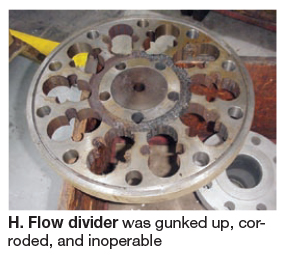
This article originally appeared in the Third Quarter, 2009, Combined Cycle Journal Online.
The auxiliaries session of the May meeting included open discussion of experience with liquid-fuel systems for dual-fuel engines. Only a couple of years ago, some owner/operators were disabling or removing their liquid-fuel systems both because they weren’t being used and they added to the complexity and cost of annual inspections.
Recently, a few gas-only engines have been or are being converted to dual fuel because of grid-reliability concerns (example at www.combinedcyclejournal.com/archives.html, click 2Q/2009, click “Termocandelaria” on the issue cover).
Municipals and cooperatives, in particular, are specifying dual fuel for new units and improving the functionality of liquid fuel systems on existing gas turbines (GTs)—this to assure native load doesn’t go dark in the unlikely event gas supply is interrupted. Recall that public power companies are owned by their customers, most of whom are voters.
During the floor discussion, one user reported good success with the OEM’s liquid-fuel recirculation system in increasing the reliability of fuel transfer at various loads. Two other users reported positively on multiple plant experiences with water-cooled check valves installed to improve the functionality of their liquid-fuel systems. The valves, manufactured by JASC (Jansen’s Aircraft Systems Controls Inc, Tempe, Ariz) prevented coking of distillate which, at a minimum, impeded operation. In extreme cases, engines wouldn’t operate at all on oil.
The coking problem many users experience with standard liquid-fuel check valves occurs after switching from oil to gas. Oil remaining in check valves, which are located close to the combustor, is exposed to high temperatures. Above about 250F that oil is oxidized. The resulting coke coats check-valve internal surfaces (and fuel lines as well) and restricts the movement of valve parts. Once this occurs, a check valve will not open and close properly until it is overhauled. The most common trip during fuel transfer is on high exhaust-spread temperature—caused almost exclusively by check valves “hung-up” on coked fuel.
To get a first-hand look at the issues faced by users with dual-fuel GTs and the role played by JASC valves in solving some of those problems, the editors talked to one 7FA owner/operator and one 7EA user—the latter at the recent Fall Turbine Users Forum conducted by the Combustion Turbine Operations Task Force (CTOTF).
7FA Experience
Schuyler McElrath, JASC’s expert on fuel systems for large frame engines, told the editors at the vendor fair that Progress Energy Carolina’s Richmond County Energy Facility had more experience with the company’s water-cooled liquid-fuel check valves than any other generating plant. So COMBINED CYCLE Journal spoke with David Saad, O&R (operations and results) superintendent.
The station has five simple-cycle 7FAs and one 2 × 1 7FA-powered combined cycle. All engines are equipped for dual-fuel firing and have DLN2.6 combustion systems. Plus, all have JASC water-cooled liquid-fuel check valves—14 per GT (one per combustor). The first engine was equipped with the valves in 2006. When the 2 × 1 Siemens 501F-powered combined cycle is completed, the station will have a summer rating of about 1900 MW.
The peakers each start 100 to 200 times annually and run between about 1000 and 1500 hours. The combined-cycle is a mid-range unit. Unit run time on distillate ranges from about six to 25 hours annually today—virtually all of that to keep the liquid-fuel systems exercised. The few check-valve problems experienced, Saad said, were cooling-water related.
Water for valve cooling comes from the closed cooling-water system, which recirculates a mixture of water and glycol. The fin-fan cooler for the peakers supplies water at about 130F in summer; that for the combined cycle, about 150F. Such hot water for cooling is not problematic because the goal is to keep the check valves under 250F.
Saad recalled that fuel-transfer reliability was in the low 60s (percent) with standard check valves and the reason why the plant switched to JASC. Today transfer reliability is in the upper 80s. Saad cautioned that not all fuel-transfer failures are related to the check valves.
Installation was not difficult, he continued. Plant personnel prefabricated all the lines after the trial installation, which took about two days per unit. Staff also did the installation—typically a day for each engine. Early on, Saad added, they operated the check-valve cooling circuit with a delta P that was too high: 50 psi. Overcooling allowed unwanted wax to come out of solution. Reducing the differential pressure to 12 psi eliminated the issue.
Finally, Saad said, to assure that the plant maintains fuel-transfer reliability at a high level, check valves are removed each combustor and hot-gas-path inspection and returned to JASC for servicing. He does not want any failed fuel transfer attributed to a check-valve problem.
7EA Experience
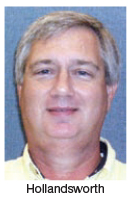
Dave Hollandsworth, GT principal engineer for Gainesville Regional Utilities (GRU), walked the editors through his experiences with dual-fuel engines. It made War and Peace seem like a short story. GRU has several generating units, including a 235-MW coal-fired steam unit, but the Florida city’s DLN-1 equipped, dual-fuel 7EA is the sole focus here. Installed in 1996, it does 120-150 starts annually.
By way of background, Hollandsworth joined Gainesville in August 2002 after working for two major investor-owned utilities in the South. One of many items on his “to-do” list: Get the largest of the utility’s three gas turbines at the Deerhaven Generating Station (there are two Frame 5s in addition to the 7EA) operating reliably on distillate oil.
Water-cooled liquid-fuel check valves were one part of the solution, Hollandsworth told the editors, but only one part. However, the entire history of the engine is worth a quick read because it illustrates the importance of exercising standby fuel systems regularly if you expect them to perform properly when needed.
One of the first things the new hire did was to piece together an operational history for the engine. Here’s what he learned:
- Historically, the unit had operated on gas. Operation on gas was assumed satisfactory because Hollandsworth found no documentation to the contrary.
- Periodic operation on oil was confirmed by the need to replace leaking liquid-fuel check valves in December 1996.
- In fall 1998, the buildup of coke was sufficient to damage some crossfire tubes, which were repaired/replaced. Coking issues persisted and more crossfire tubes were replaced about six months later.
- A spate of operational problems traced to liquid fuel led to the replacement of check valves with the OEM’s newly designed three-way purge valves in fall 1999. Hollandsworth said the job report claimed proper operation through all load ranges on gas and oil, as well as successful fuel transfers.
- Discussions with operations personnel indicated that coking issues soon reappeared. Evidently, the unit would operate on gas for hours with distillate trapped in the liquid fuel system. Later attempts to run on oil would be unsuccessful. It appeared to Hollandsworth that the plant just gave up on liquid fuel at that point and ran on gas.
Fuel quality. The foregoing findings got Hollandsworth thinking about the quality of fuel in storage. Analysis revealed a stability rating of 15, indicating the fuel was unstable. Chemists told him a stability number above 7 is unsatisfactory. Fuel treatment brought the stability rating down to 2, but it just doesn’t stay there—especially in the heat and humidity of Florida. Semi-annual retesting was recommended, with follow-up treatment when necessary.
Additional tests were run on the “satisfactory” fuel to better understand its tolerance for heat. GRU engineers determined that GT compartment temperature can get as high as 300F and wanted to know how long it would take for the fuel to start forming particulates at that temperature. The answer: six hours. That meant any liquid fuel remaining in the system probably would begin to coke during the next run on natural gas.
Hollandsworth had joined the company just before the first hot-gas-path inspection in January 2003. One finding: Some secondary fuel-nozzle tubes were completely plugged with carbon deposits. During tuning after the HGP, engineers found some secondary liquid-fuel “pigtail” lines completely plugged with carbon.
Fuel lines and nozzles were cleaned in the spring and the plant began testing on liquid fuel again in June. No issues were encountered in the primary circuits, but the water injection system for the secondary circuits had problems—the most obvious was frozen flowmeters attributed to lack of exercise.
An inspection and rehabilitation plan was prepared for the water injection system, but work was postponed for more than a year because personnel were reassigned to address issues associated with forced and scheduled outages of the main coal-fired unit. The days of large unit-dedicated staffs are history. Today everyone works on everything.
Testing resumed on liquid fuel in June 2005, but a high temperature spread at 12 MW with only the primary nozzles in service tripped the unit. Liquid fuel sat in the pigtail lines for almost two years while the unit operated on gas. Hollandsworth said that, according to the Mark V timers, the 7EA had accumulated only seven hours of operation on liquid fuel since unit installation nine years earlier.
It was clear that proper operation of the liquid fuel system hinged on reducing the exposure time of oil to high heat or reducing the temperature of the oil, or a combination of both. One idea was to purge oil from the system (end cover to burner front) using nitrogen or atomizing air.
Problem with this approach was the risk of flame out on transfer from gas to oil under load because of empty fuel lines. In addition, there would still be some seals and o-rings in the three-way purge valves exposed to distillate and they would be prone to deterioration and gum-up by particulates.
Hollandsworth began discussions with JASC after speaking to McElrath at a user group meeting and came away thinking that water-cooled check valves were a viable solution. They would allow changing fuels under load while holding temperature below the threshold for particulate formation. Experience at other sites confirmed this.
GRU purchased the water-cooled check valves, purge-air check valves, tubing, and other components recommended by JASC to modify the liquid-fuel system during the combustor inspection planned for January 2008.
It’s important to recognize that the switch to the JASC solution was not a matter of just cutting out a few valves, welding in some new ones, and hooking up water supply and return lines. Also needed was OEM support to modify the Mark V controls from three-way purge-valve operation to water-cooled liquid-fuel check valve operation.
PAL Engineering, a unit of Pond And Lucier LLC, Clifton Park, NY, was retained as GRU’s technical advisor for the combustor inspection. Project Manager Carlo Barrera, mechanical TA and startup engineer, said this CI essentially was a modified HGP that took nearly eight weeks and included the following tasks:
- Convert from three-way purge valves to water-cooled check valves.
- Replace first-stage turbine nozzles, which exhibited severe cracking.
- Clean the fuel-oil system to assure as-new-as-possible condition prior to restart.
- Repair exhaust frame.
- Analyze turbine casing crack.
- Replace fuel nozzles.
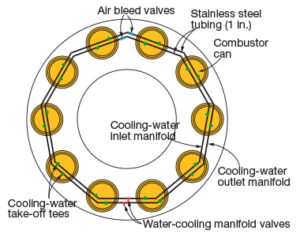
Barrera said this was his first experience with the JASC solution. He rated the project “challenging,” primarily because of the controls-logic changes necessary, a different basket of plumbing hardware to deal with, prefab effort, fuel system cleaning, etc. Water for cooling the check valves comes off the closed cooling-water system (70% water, 30% glycol), which also supplies the lube-oil cooler and other auxiliaries—including the small heat exchanger that reduces the temperature of compressor discharge air for purge, atomizing, and fuel-nozzle cooling purposes.

Hollandsworth added that 1-in.cooling-water supply and return manifolds were installed (Fig A) to serve all combustors in parallel. Fig B shows that cooling water flows to the primary fuel nozzle first and then to the secondary nozzle (in series). A water-cooled check valve, as installed, is in Fig C, with a drawing to illustrate how the valve works in Fig D.
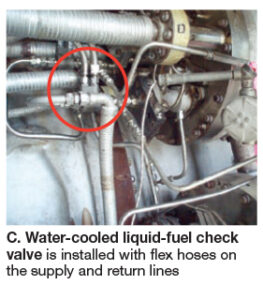
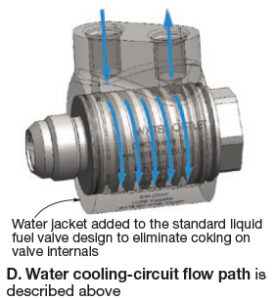
Cleaning of the fuel system required an effort that should not be underestimated, continued Hollandsworth. He said a holistic approach was used to make sure the job was done properly. Hydrolazing was used to cut through coke in fuel lines and remove it from the system. System clean-up took about a week. Truck with necessary equipment is in Fig E, worker protection required in Fig F. Process gets results: Coke removed is in Fig G.
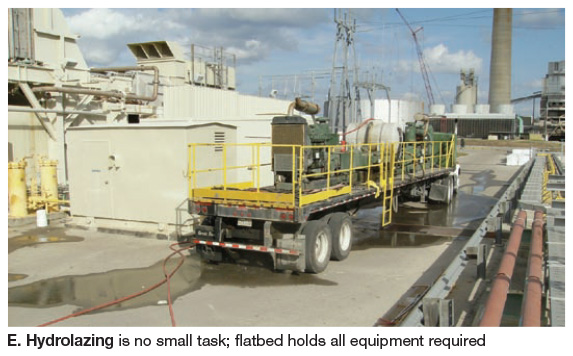
Among the problems identified: (1) The flow divider was gunked up, corroded, and inoperable (Fig H); it was replaced. (2) The selector valve was plugged (Fig I) and refurbished. (3) Purge-air solenoids for the secondary-fuel circuit were found inoperative.
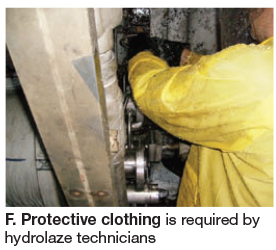
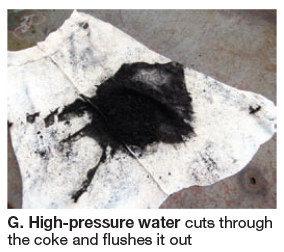
All work complete, recommissioning of the liquid fuel system was reasonably straight-forward. The system has been exercised monthly for the last year and has met expectations. It also has participated successfully in alerts, which requires burning oil. GRU’s standard 30-min test: Unit is started on gas, switched to oil and run up to at least 60 MW, allowing check-out of the primary and secondary purge-air and water-injection systems. Then load is reduced and the unit transferred back to natural gas for shutdown. After shutdown, atomizing air and check-valve cooling water continue to run for eight hours.
